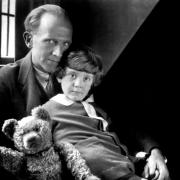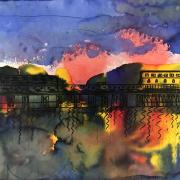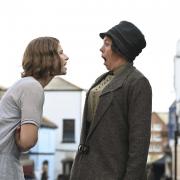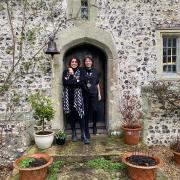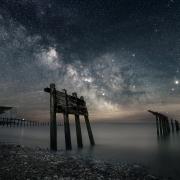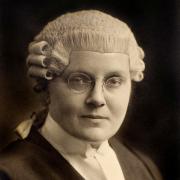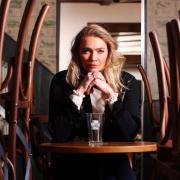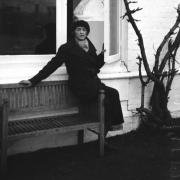Sir Ernest Shackleton undertook four expeditions to the Antarctic. He became a world-famous celebrity and mixed freely with kings, queens and public figure. But it was East Sussex that he called home, as his biographer

In the summer of 1914, just a few hours before Britain declared war on Germany, the famous explorer Sir Ernest Shackleton took a train from Eastbourne to London. He was on his way to Buckingham Palace to meet King George V before embarking on his dramatic Endurance expedition to the Antarctic.
Despite the gravity of the crisis, the King put the monumental affairs of state aside for almost half an hour to meet Shackleton. The pair got on well and Shackleton, fully aware of the looming war, offered to put his ship and crew at the nation’s disposal. However the King insisted that the expedition should go ahead and presented Shackleton with a silk Union Jack to carry south into the ice. A few hours later Endurance left Eastbourne for the Antarctic and Britain formally declared war.
This was among many moments where the county of Sussex featured in the life of Shackleton. While Shackleton will always be associated with the frozen wilderness of Antarctica, Sussex runs a comfortable second.
It was in Sussex where Shackleton courted his wife and pondered becoming an explorer and it was in Sussex he made his final home. His wife continued to live in Eastbourne and retained the Sussex connection long after his death.
It was the love of a woman called Emily Dorman which first brought Shackleton to Sussex. By the late 1890s, Shackleton, who was born in Ireland and came from Quaker stock, was a middle-ranking officer in the merchant fleet with a family home in Sydenham, south London. Emily, who was friends with one of his eight sisters, lived nearby and Shackleton was smitten.
Emily Dorman was an attractive, educated woman in her early 30s who had rejected numerous other proposals of marriage, but was unsure about Shackleton. So, too, was her father, the wealthy and respected London solicitor Charles Dorman.
Dorman, a one-time Master of Skinners’ Company in the City of London and Chairman of the Royal Horticultural Hall, decided to take the measure of Shackleton by inviting him to the family farm among the pastures of Tidebrook Valley, near Wadhurst. Dorman was a very keen horticulturalist and said to be among the earliest growers of orchids in England. On other occasions Shackleton visited Eastbourne, where the Dormans had a summer house. Shackleton was effectively on probation.
While Emily played hard to get in the Sussex countryside, Shackleton wondered how to make a lasting impression and win her hand. In 1900, he took the drastic step of applying to join Captain Robert Scott’s pioneering Discovery expedition to the Antarctic. It was the first attempt by any nation to explore the interior of the unknown Antarctic continent. But it was a lot more for Shackleton. As one family member explained, he wanted to “lay the world at Emily’s feet.”

In 1901, on the eve of departure for the ice, Emily finally relented and agreed to marry the would-be explorer. In keeping with the times, Shackleton wrote to Charles Dorman asking for permission to marry his daughter. But he feared Dorman would reject his proposal and arranged for the letter to arrive only when Discovery was far out to sea en route to the Antarctic and beyond recall.
Fate intervened, however. By the time he opened the reply months later, Charles Dorman was already dead. Among his final wishes was to approve his daughter’s marriage to Shackleton, which eventually took place in 1904 after his return from the Antarctic.
During his life, Shackleton emerged as a great Edwardian explorer on four Antarctic expeditions. He marched to within 97 miles of the South Pole in 1909 and opened the route to the Pole itself for Roald Amundsen and Captain Scott who followed in his footsteps a couple of years later. The epic Endurance expedition of 1914-16, when his ship was crushed by the ice and Shackleton made the daring open boat journey to South Georgia to rescue colleagues marooned on Elephant Island, is the greatest survival story in the history of exploration. All 28 men survived the two-year ordeal and Shackleton became a symbol of what became known as the Heroic Age of Antarctic exploration.
Shackleton became a world-famous celebrity who was knighted and mixed freely with kings and queens, presidents and prime ministers and many public figures. His name can be found in the visitor’s book at Bateman’s, the Burwash home of Rudyard Kipling, and among the private sponsors of his Antarctic expeditions was Elizabeth Dawson Lambton, a wealthy spinster from Eastbourne. A rough sketch of plans for one Antarctic expedition was scribbled on a napkin from Eastbourne’s Grand Hotel.
Shackleton and Emily were constantly on the move during what became a difficult marriage, despite the arrival of three children. It was a chaotic relationship marked by Shackleton’s restless urge to escape to the ice, his frequent extra-marital affairs and a string of failed business ventures. Shackleton found domestic responsibilities very testing and was only happy on the ice. Fortunately Emily’s father had left her a decent legacy and she was not wholly dependent on her husband to provide for the family.
Some time around 1916, while Shackleton was orchestrating the dramatic attempt to escape from the loss of Endurance, Emily moved the family to Milnthorpe Road, Eastbourne. It was perhaps the longest they stayed anywhere and a blue plaque was placed on the house in 1994.
It was at Milnthorpe Road that Shackleton enjoyed his penultimate family Christmas in England and from Eastbourne where his ship Quest stopped off before sailing on his last voyage. Before departure the Eastbourne Gazette captured a last poignant image of the five members of the Shackleton family – Shackleton, Emily and the children Raymond, Cecily and Edward – standing on the Quest’s deck. Shackleton died in South Georgia less than six months later. He was 47 years old.
Emily Shackleton insisted that he should be buried on the island of South Georgia surrounded by towering mountains and sweeping glaciers and carried to his grave by other restless misfits and itinerant seamen. She knew only too well where he was happiest.
Emily remained at Eastbourne for a few years after her husband’s death where she became local divisional commander for the Girl Guides. Cecily, just 15 years old when her father died, attended Roedean School on the outskirts of Brighton. It was from Milnthorpe Road that Emily advised the Polar expert Hugh Robert Mill to write the first full biography of Shackleton from his home in Dormans Park, East Grinstead.
Sir Ernest Shackleton, often seen as the classic Edwardian explorer, will forever be associated with exploration of Antarctica. Even today his extraordinary exploits are inspiring modern generations of adventurers.
It is no exaggeration to say there is a little bit of Sussex in exploration’s most Heroic Age and its most charismatic adventurer.
Michael Smith’s Shackleton – By Endurance We Conquer (Oneworld Publications), is the first comprehensive biography of Sir Ernest Shackleton in more than 30 years. He is an authority on the history of Polar exploration who has written nine books, appeared on TV and radio and lectured extensively. Michael lives in East Sussex.
More…
• Ben Fogle on his new book and why it’s an interesting time to be English - Television presenter and adventurer Ben Fogle’s latest book examines the strengths and foibles of the English national character. He tells Jenny Mark-Bell about childhood Christmases in Arundel, and presents an extract from English: A Story of Marmite, Queuing and Weather




